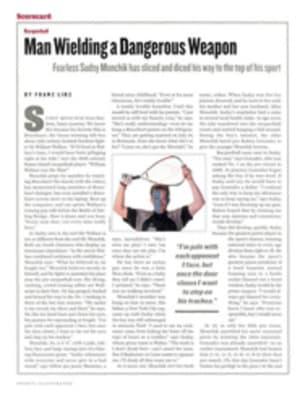
Taking Out a Mortgage on the Future
The world's most popular sport has long been in search of a proper American home. Soccer in the U.S. has either been miniaturized to fit inside basketball arenas, or it has been presented in cavernous baseball and football stadiums, where it has been dwarfed by the silence of empty seats. Now, after so much yapping about the game's potential for growth in the U.S., someone has finally taken out a mortgage on its future. Lamar Hunt, owner of MLS's Columbus Crew and American pro soccer's most resolute investor for three decades, has built a model home for the sport. Columbus Crew Stadium seats 22,485, though when it opened on May 15 an extra 2,256 fans found a way to wedge themselves in for a game against the New England Revolution.
For its first three years the Crew played in Ohio State's 89,841-seat football stadium, which is certainly no slum. "As good as everything was for us there, every time we walked into Ohio Stadium it was as if we were saying to them, Thank you for letting us play," Columbus coach Tom Fitzgerald said last Thursday night after his players had finished training on the floodlit bluegrass of their new stadium. "It's nice to come into a place and not have to say, Sorry for being here."
While his teammates were practicing, the Crew's injured captain, Brian McBride, acted as an impromptu tour guide of the new facility, which Columbus christened with a 2-0 victory over the Revolution. McBride was proud of the stadium amenities, which are taken for granted by richer athletes: the air conditioning in the locker room, the stylish merchandise shop and the gentle eight-inch crown built into the field for drainage. "Sometimes when we play on football fields the crown is so huge that the ball rolls out of bounds on its own," McBride said. The floodlights are attached to four angled towers that lean over the field from each corner. Under normal football lighting, McBride said, "when you look up for the ball on a corner kick all you see is a row of lights. You won't get that here—all you'll see is a lit soccer ball."
The new stadium took nine months and one day to build, at a cost of $28.5 million to Hunt. As with baseball facilities constructed early in the century, including Fenway Park and Tiger Stadium, the Crew's digs offer fans an intimate relationship with the game. Even the concession stands overlook the field, permitting customers to stay on top of the action as they feed themselves. As a matter of economics few expensive gimmicks have been included; the so-called luxury boxes are open-air with cinder-block walls. The stadium was modeled after the parks of medium-sized first-division clubs in Europe, where fans tend to watch their soccer in intense 45-minute blocks without music, videos or other artificial additives. It may be unpretentious by NFL standards, but then its mission is to help the sport create an American identity.
"This will be what our soul is all about," says MLS commissioner Doug Logan, who predicts that similar cozy stadiums will be built in Denver, Los Angeles and New York in the next five years, though none of the stadium projects in those cities are beyond the talking stage. In the meantime the Crew hopes to lead the way by establishing the strongest home field advantage in MLS. If the stadium happens to have the airs of an unfinished warehouse, then that fits nicely with Columbus's hard-hat logo and its self-proclaimed image as "America's hardest-working team." (Despite having to play its first seven games on the road while the stadium was being finished, Columbus is tied with D.C. United atop MLS's Eastern Conference standings.) The stands are made of aluminum, which resounds loudly when 20,000 fans stamp their feet in mass approval. With an average seat price of $13.50, the Crew hopes to increase its league-high season-ticket base of 9,000 for the 16-game home season.
"What this stadium does is get people involved," says McBride, a U.S. team striker who earlier this month had fractured his left cheekbone. The doctors told McBride he would be sidelined until late June, but as he walked around the edges of the stadium, he kept glancing toward his teammates on the field. It was too much for McBride. He went into the Crew's locker room and five minutes later reappeared on the field in his practice uniform. He ran behind one of the goals and kicked a ball to himself against the low concrete wall, as if he were in the backyard of his parents' house, playing at home.

